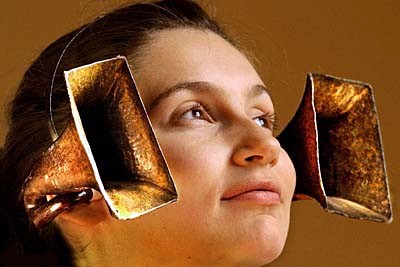Some Less Successful Projects.
|
| |
Updated: 30 Oct 2009
The real truth about Project 4
The photographs shown here have not been modified in any way.
 
| | |
CONTENTS.
 |
| PROJECT 1.
Early attempts at improving stereo localisation.
The Sober Truth about this picture.
|
 |
| PROJECT 2.
First steps in developing the vinyl-disc Walkman; the head-mounted turntable. A high moment of inertia was considered essential to reduce wow & flutter.
The inevitably fatal results of bearing seizure led to the abandonment of the project.
The Sober Truth about this picture.
|
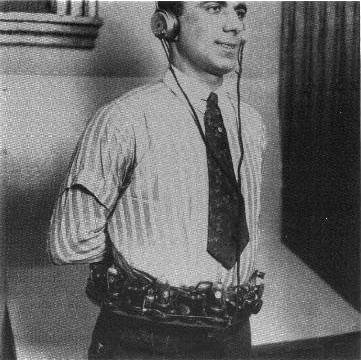 |
| PROJECT 3.
More faltering steps toward the first Walkman. With this prototype there was a severe risk of getting a belt from the HT.
The Sober Truth about this picture.
|
 |
| PROJECT 4.
Striving for the ultimate tweeter; the upper audio octaves are divided between 44 different tweeters, mostly horn-loaded, by means of a rather complex crossover. It may not have sounded very good but it certainly got your attention.
The Sober Truth about this picture.
|
 |
| PROJECT 5.
The "1812 Adaptor" was conceived to allow the listener to experience the real impact of gunfire in the famous overture. The breastplate is fitted with 19 solenoid-triggered flintlock pistols (to evade firearms legislation) which were fired in sequence from a sound effects channel via a MIDI interface, providing some very real force-feedback to the chest. Naturally the barrels had to be loaded with real lead bullets to give sufficient recoil and hence the full emotional impact.
In early tests a software error triggered all 19 barrels prematurely, and the resulting casualty list of Institute employees led to the project's cancellation.
The Sober Truth about this picture.
|
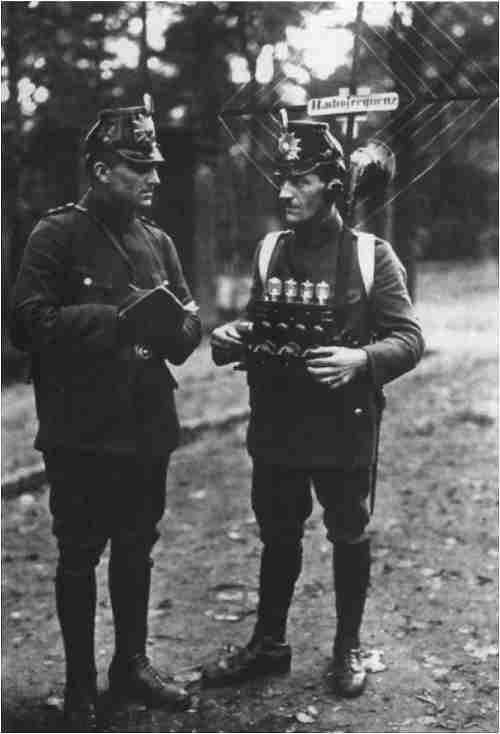 |
| PROJECT 6: THE AUDIO POLICE.
"Zo, Hans, the treble is veiled, und dere is some smearing of zer transients?"
A momento of one of the Institute's less successful international co-operations.
There have been conflicting interpretations of this project in the press. According to one school of thought, this was just another premature attempt at developing the radio walkman. Another group holds that the policeman on the left is busting the one on the right for not having a radio licence. A third opinion completely misinterprets the rear-firing bass port behind the policeman's head, and assumes that this is some sort of early jet-pack.
The truth of the matter is that economic conditions in Germany after the First World War rendered anechoic chambers impractical and so all Subjektivist listening tests were conducted in the open air.
Both men wear the insignia of the Audio Police. Rumour has it that since it proved impossible to prevent the experimental subjects arresting each other, the project was cancelled.
The Sober Truth about this picture.
|
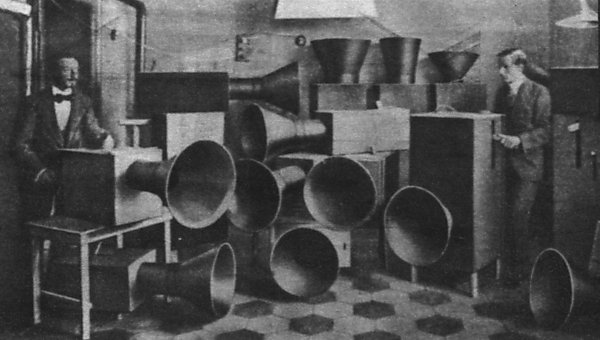 |
| PROJECT 7: THE "JERICHO" SUB-WOOFER.
Just before the first trial of the "Jericho" 12-way sub-woofer system. Note horns firing in various different directions so that one of them might be appropriate. The Institute employee on the right is just about to connect the compressed air main, his expression indicating his confidence in the equipment under test.
The search for survivors has been abandoned.
The Sober Truth about this picture.
|
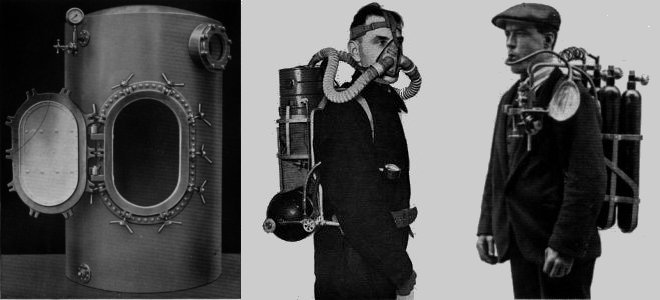 |
| PROJECT 8: THE OXYGEN-FREE LISTENING ROOM.
If oxygen-free copper is a good thing, then clearly oxygen is a bad thing for audio. The largest quantity of oxygen the sound is likely to encounter is in its passage through the air from loudspeakers to listeners. The only way to address this is: The Oxygen-Free Listening Room, which is filled with pure nitrogen.
On the left , breathless with excitement, a couple of brave "volunteers" prepare for a listening session. The "listening room" is on the extreme left.
There have been criticisms of the acoustics of a steel cylinder, but this is the kind of petty-minded carping that greets every major breakthrough.
The Sober Truth about this picture.
|
 |
| PROJECT 9: THE MINIMAL SURFACE-AREA OVERCOAT.
It has long been held that the amount of absorbant material in a listening room has a crucial effect on the acoustics and hence the listening experience. Following the hypothesis that the amount of clothing worn by the observers was a critical factor, and was in general too great in area, there was clearly one obvious route to take.
However, the Institute staff have never been satisfied with the obvious, and rejected the hazardous route of naturist subjectivism. Instead a whole new style of clothing was evolved, based on the principle that the total absorbant surface area is reduced if one piece of clothing encloses two people. Pictured here is the Mk I critically-damped stereo overcoat, for listening in cooler climates. The high-capacity cap is an optional extra.
The Sober Truth about this picture.
|
 |
| PROJECT 10: THE WALL OF SOUND.
How do you reproduce a "wall of sound"? With a wall of speakers of course. Clear evidence that the experts of the Institute can be frighteningly literal-minded. Here a "volunteer" adjusts horn-loaded unit No 1437, painfully aware of the consequences of someone dropping the needle on the record... oops.
Phil Spector was not involved in the design process.
The Sober Truth about this picture.
|
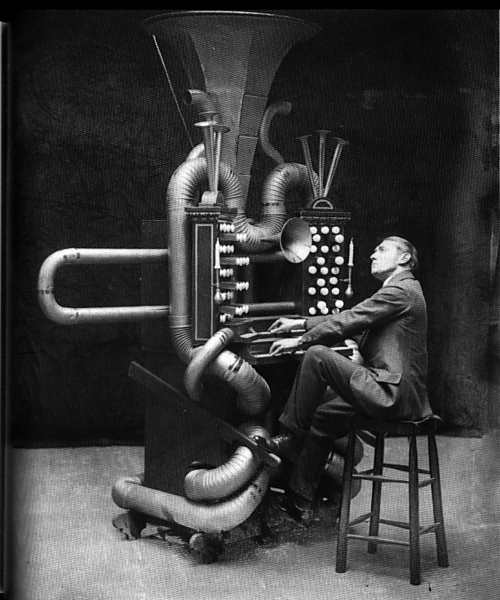 |
| PROJECT 11: THE LAOCOON LOUDSPEAKER.
Moving somewhere in the uncertain middle ground between loudspeaker and church-organ, the Amplifier Institute Laocoon Loudspeaker was a demanding example of interactive audio technology. Every Thiele-Small parameter, and quite a few others, could be manipulated in real time for the optimal musical experience. Note the user/victim shown here has been obliged to use his left foot to control No 4 Bass Damping Control lever. Note also that he is raising his eyes to heaven, as well he might.
Students of classical literature will understand the name Laocoon borne by this snappy bit of technology. See Wikipedia.
The Sober Truth about this picture.
|
 |
| PROJECT 12: AMPLIFIER DEBUGGING.
The staff of the Amplifier Institute have always been noted for a rather literal approach to matters. Here a technician attempts a physical approach to debugging a valve amplifier.
Regrettably any insect life removed from between the capacitor plates was found to have been replaced with heavy deposits of fag ash.
The Sober Truth about this picture.
|
THE SOBER TRUTH.
PROJECT 1: Surprisingly, not far off the truth here. This remarkable device was invented by Frenchman Jean Auscher as an acoustic navigation device in case of radar failure on small vessels. Shown at the 1960 Brussels Inventor's Fair, and, one suspects, nowhere else ever again.
The lady's model: according to the information I was originally given, this Victorian-era device was used to aid communication between sailors shouting between ships. However it also stated that the horns were made of papier-maché, which is not a material noted for its durability under seagoing conditions. Personally I suspect it is a hearing-aid, possibly for use at concerts.
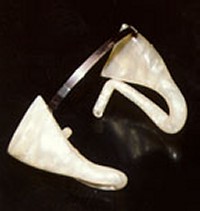 |
| Left: This is definitely a binaural hearing aid, complete with flexible headband. Point proven, I think.
For more information on enhancing the capabilities of the human ear, see Acoustic Location.
|
PROJECT 2: This is actually a stunt by an Englishman (known only as Henry) performed in 1952. The cartwheel was dropped from some three feet above him, and he caught it on his spiked headgear.
PROJECT 3: A homemade portable radio in 1935. Carrying the filament accumulator around must have been fun.
PROJECT 4: Extensive research has now revealed that this collection of motor-horns was on test at the National Physical Laboratory, Great Britain, in 1929, presumably to see if their acoustic output was up to standard.
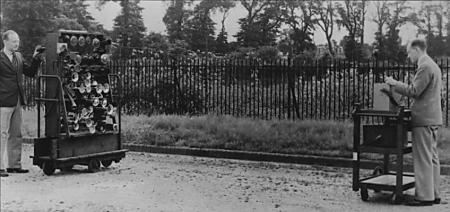 |
| This appears to be the original photograph before cropping and mirroring.
The man on the right is standing behind a microphone- the large box on the trolley.
|
 |
| PROJECT 5:
"Come on then, if you think you're 'ard enough
..."
It really is a steel cuirass, mounted with 19 pistols, and weighing about 30 pounds. Worn in the picture above by collector Charles Noe Daly. Found in Bordeaux, 1917; sold at auction in Toronto in 1935.
Left is another picture of Daly, with his weaponry less erect. In his right hand he holds a sword-revolver. In his left hand he holds a pair of pistol-stirrups. These have rear-facing barrels so you could shoot backwards with your feet while being pursued on horseback, though the chances of hitting anything (except your own horse) must have been very small. I couldn't make this up.
Charles Daly was probably not a good man to cross.
|
PROJECT 6: These are indeed German policemen, post WW1. Obviously trials of an early portable radio of very doubtful practicality. I understand the sign on the aerial says "Radiofrequenz", a contemporary radio manufacturer who built a 4-valve receiver that looked very like the one in the picture; thus:
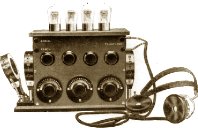
There is no sign of a portable transmitter, which may have been impractical at that date.
See http://www.gfu.de/pages/history/his_radio_04.html (external link)
And for Heaven's sake, it's not who you think it is on the right. Photo 1923/24.
.
PROJECT 7: The gent on the left is Russolo, the Italian Futurist composer, proudly displaying his "noise-machines" or "intoners" (intonarumori), for use in his avante-garde musical compositions. Each made a preset "roaring, bubbling or bursting" noise when its handle was operated. In his often quoted manifesto from 1913, l'arte di rumori, Russolo proposed an Art of Noise. Good name for a band...
See Luigi Russolo and the Italian Futurists (external link)
Photo: Milan circa 1920.
Below: some more pictures of intoners. None of these machines survived WW2.

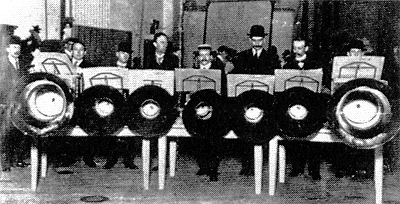
PROJECT 8: The tank is a high-altitude (low pressure) test chamber, installed at Siebe, Gorman's works in 1912, and used by Prof J S Haldane & others. The two men are wearing the oxygen equipment that was used in the heroic but unsuccessful British attempts to climb Everest before WW2. The middle pic shows a regenerative apparatus, where the CO2 is absorbed from a closed breathing circuit. On the right is a total-loss system where the user simply breathes in oxygen.
Bibliography: "Breathing In Irrespirable Atmospheres" Robert Davis. St Catherine Press.
PROJECT 9: I really haven't a clue what's going on here. Probably some sort of publicity stunt.
PROJECT 10: Not for the first time here, the truth is dafter than the fiction. This is an array of loudspeakers installed in South Korea, near the border with North Korea, for shouting propaganda across the Demilitarized Zone.
PROJECT 11: This is actually a fake musical instrument called the Follyphone. It was designed by Mr Lewis Sydney (the artiste in the picture) to take the piss out of the new musical instruments being devised at the time; presumably he felt this needed doing. Date of photo is September 1912.
The basis of this construction is clearly a small church organ; the lever he has his foot on was originally used to actuate the bellows.
PROJECT 12: It looks like our hero has taken his three-valve radio apart to get the fluff out of his tuning capacitors. As to why this activity was thought worthy of photography, I have no idea.









